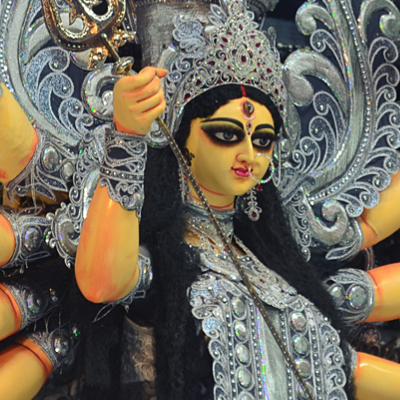No products in the cart.
Navratri 2016

01st
October 2016
(Saturday)
Navratri Starts in : 01/10/2016
Navratri Ends in : 21/10/2015
2016 Navratri

Navratri
Navratri 2016
Navratri Puja Timings
Pratipada Tithi Begins = 05:41 on 1/Oct/2016
Pratipada Tithi Ends = 07:45 on 2/Oct/2016
Navratri is the nine-day festival dedicated to Goddess Durga celebrated in the lunar month of Ashwin or Kartik (September-October). Navratri is a Sanskrit word which literally means nine nights. During these nine nights and ten days, Goddess Durga is worshipped in 9 different forms, known as Navdurga. The tenth day is celebrated as Vijayadashami when idols of Goddess Durga are immersed into the water body.
Navratri is celebrated in most of the Indian states. However Navratri is very popular festival in the western states of Gujarat, Maharashtra and the southern state of Karnataka. On the very first day of Navratri, Goddess Durga is invoked into a Kalash with full Vedic rituals along with chanting of Mantras. The invocation and dwelling of Goddess Durga into the Kalash is known as Ghatasthapana or Kalashsthapana and is done at an appropriate time of the day.
In West Bengal Navratri is celebrated as Durga Puja. In West Bengal, Goddess Durga is worshipped on the last three days of Navratri and these three days are famously known as Durga Saptami, Durga Ashtami and Durga Navami. It would be correct to say that Durga Puja in West Bengal is a smaller version of 9 days Navratri. Kalparambha and Bilva Nimantran during Durga Puja, which is done on the sixth day of Navratri, is symbolically same as Ghatasthapana or Kalashsthapana in other states.
Hindu religious books suggest 7 day Navratri, 5 day Navratri, 3 day Navratri, 2 day Navratri or even 1 day Navratri as an alternative to the 9 day Navratri.
Jyoti Kalash, Kumari Puja, Sandhi Puja, Navami Homa, Lalitha Vrat and Chandi Path are other famous rituals and events which are observed during 9 days Navratri.
Being a universal festival, Hindus celebrate this festival at the same time in different ways in different parts of India as well as around the world.
In the northern part of the country, the first nine days of this festival, called Navaratri, is commonly observed as a time for rigorous fast, followed by celebrations on the tenth day (Dusshera). Especially in Varanasi of Northern India, Dusshera overlaps with “Ramlila” or “Rama Drama” – traditional plays in which scenes from the epic saga of the mythical Rama-Ravana strife are enacted by professional troupes.
In western India, throughout the nine days, both men and women participate in a special kind of dance around an object of worship. Especially in Gujarat, people spend the nine nights of Navaratri (nava = nine; ratri = night) in song, dance and merriment. Garba is a graceful form of dance, wherein women dressed in exquisitely embroidered choli, ghagra and bandhani dupattas, dance gracefully in circles around a pot containing a lamp. The word “Garba” or “Garbha” means “womb”, and in this context the lamp in the pot, symbolically represent life within a womb. Besides the Garba is the “Dandia” dance, in which men and women participate in pairs with small, decorated bamboo sticks called dandias in their hands.
In the south, Dusshera or the tenth day is celebrated with a lot of fanfare, especially the celebration in Mysore is a veritable extravaganza! It is a festival to celebrate the triumph of good over evil, and marks the defeat and death of the demon king Ravana in the epic Ramayana. Huge effigies of Ravana are burnt amidst the bangs and booms of firecrackers.
In the east, people go crazy over Durga Puja, from the seventh till the tenth day of this annual festival. Especially in Bengal, this is the principal festival during Navaratri. It is celebrated with gaiety and devotion through public ceremonies of “Sarbojanin Puja” or “community worship”. Huge decorative temporary structures called “pandals” are constructed to house these grand prayer services, followed by mass feeding, and cultural functions. The earthen icons of Goddess Durga, accompanied by those of Lakshmi, Saraswati, Ganesha and Kartikya, are taken out on the tenth day in a triumphal procession to the nearby river, where they are ceremonially immersed. This marks the end of the Goddess’ brief visit to the earth. As Durga leaves for Mount Kailash, the abode of her husband Shiva, it’s time for “Bijoya” or ”Vijayadashami”, when people visit each other’s homes and exchange hugs and sweets.
Although, the Garba Dance of Gujarat, Ramlila of Varanasi, Dusshera of Mysore, and Durga Puja of Bengal need special mention, the universal nature of the festival is often found to transcend regional influences and local culture.
